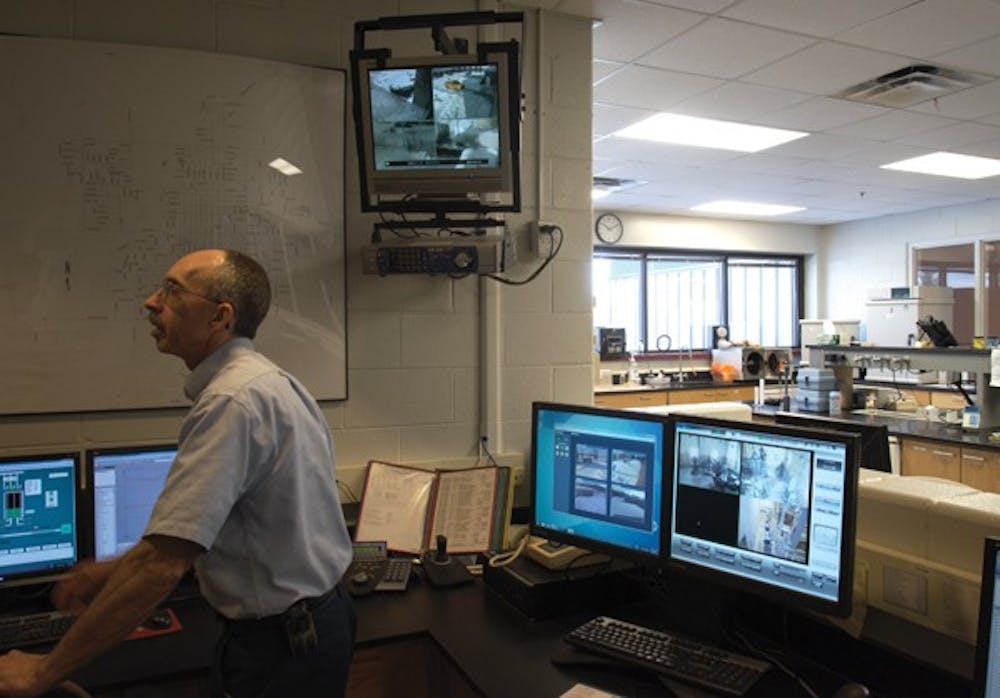Mount Pleasant Water Department works to quench residents thirst

Editors note: The photo cutline was corrected to accurately identify the subject.
When Malcolm Fox turns on his kitchen faucet he sees his team's tireless labor swirling in the crystal-clear water.
As the superintendent of the Mount Pleasant Water Department and the manager of the Mount Pleasant Water Treatment Facility, 4195 S. Lincoln Road, Fox understands why people wouldn't know much about the water system, let alone how it works.
"Why would they?" Fox said. "You're not going to know about the water system unless you're learning about it."
Although the inner workings of the city's water department is not well known to the general public, its contributions to everyday society are countless.
The water department disinfects the water, reduces the "hardness" of water, and ensures its product is safe and pleasant to drink. Workers also monitor the grid of water mains and pipes that are five t0 six feet underneath the city, known as the water distribution system. Workers are available to test water samples that customers bring in for a $25 fee if they are curious about what comes out of their taps.
All of these functions are performed by Fox, water department assistant manager Jim Rabidioux, and seven other plant operators.
The rigorous procedures involved in each process for the nine operators are designed to meet the regulations created by the United States Environmental Protection Agency and the Michigan Department of Environmental Quality, the latter of which inspects the plant four times a year with the plant itself sending the MDEQ monthly reports.
According to the website for the Environmental Protection Agency, no negative health effects from drinking hard water have been found. However, Fox said the plant reduces the amount of minerals in water for aesthetic reasons, and because hard water is difficult to use with soap, dish washing and laundry.
With a treatment capacity of 8 million gallons a day and a storage capacity of 4.5 million gallons, the plant supplies an average of 1.5 to 2 million gallons of day in the winter, and 2 to 3 million gallons a day in the summer.
Fox, who has been the manager of the water plant since it opened in 1995, doesn't mind the never-ending work.
"It's a job that's challenging, because things change, but it's fun," he said. "We play with giant toys. When something breaks, we're the guys who go in there, dig a big hole, go in and fix things."
According to the Mount Pleasant website, raw water with potential bacteria and various minerals, such as magnesium, calcium and iron, is collected from the Ranney Collector Well – a large shallow well close to the Chippewa River – and from various other wells connected to pipes 200 to 500 feet underground.
After being treated at the plant, the water is pumped through the water distribution system, consisting of almost 100 miles of water mains throughout the city of Mount Pleasant, and into the buildings of more than 5,000 water customers. Two elevated water tanks in the city exert stable pressure to the distribution system. The entire process, from the wells to homes, takes about two to three days.
Despite its complexity, Fox emphasizes the importance of his work.
"It helps people's lives," he said. "People live their lives the way they do without having a thought for it. This is just a part of that."
Pat Southworth is one of the nine people working at and monitoring the water plant. He also believes his job makes a difference.
"Water is the lifeblood of a community, in my mind," he said.
That lifeblood has a lot of money riding on it. Built for $8 million in 1995, the plant has a yearly operating budget of $2.5 to 3 million, with $200,000 of that going toward utilities, chiefly electricity and gas.
Fox says all of the various components that are constantly going into the job are enjoyable.
"This is (like) a big moving machine," he said. "I mean, the whole system. Not just here, but everywhere. It's always moving, always changing and always has to be fixed, or improved, and thought about constantly, so it's always a fun thing to do because it's a complicated job, but it's fun."
With the city's water department being an asset fund, it operates as a business. Everything is paid for by the water bills of the plant's more than 5,000 customers, not through taxes as is commonly believed.
Water bill rates in Mount Pleasant are $2.45 per every 1,000 gallons. The department is expecting to bring in $2.7 million in revenue this year.
The plant plans on spending $3.2 million on various projects using reserves previously earmarked for different programs. One ongoing project is to replace all of Mount Pleasant's small cast iron water mains with larger, more durable plastic mains.
The plant plans to complete that objective by 2017.
Fox said the plant often hires one or two Central Michigan University students for seasonal work.
A water treatment plant manager or operator is almost always needed, Fox said. He also said the water treatment field is financially stable.
"I've never not had a job," he said. "During the recession, we had some financial difficulties. We restructured the (water) department to meet those difficulties."
Although Fox says he loves his job and enjoys the challenges of dealing with different obstacles and tasks every day, the job can also be very stressful and long hours are required, with operators often working on holidays.
For Fox, it's just part of the job.
"Somebody always has to be there, and failure is not an option," he said. "You can't say 'Well, we're not going to make any water today because everyone's sick.' or 'Things are broken'. You can't just do that. People's lives are literally depending on this. For health and for safety"



